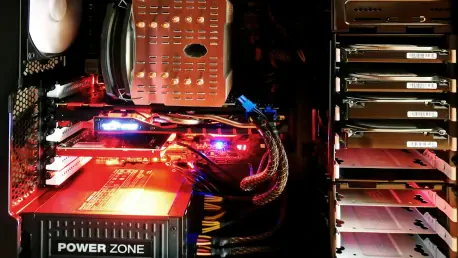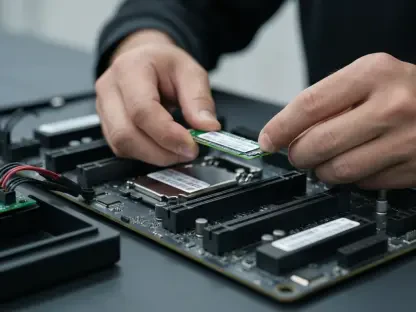Amid the ever-evolving landscape of graphics technology, Asus has introduced a remarkable innovation with the ProArt RTX 5080 SSD Edition. Designed to merge powerful graphics processing with advanced solid-state storage, this edition promises to redefine performance standards. In recent years, the drive toward optimizing artificial intelligence tools has accelerated. The RTX 5080 exemplifies this shift by supporting AI tasks with its unique blend of GPU and SSD capabilities.
Innovative Features and Performance Metrics
Integrated SSD Slot
The hallmark integration of an SSD slot into the RTX 5080 showcases Asus’s pioneering approach to hardware design. Utilizing PCIe bifurcation, it reallocates unused lanes, enhancing the drive’s support and demonstrating a strategic divergence from typical GPU setups. This design enables faster data retrieval and storage without depending on separate system drives. The SSD slot is not just an add-on; it plays a central role in facilitating local AI model development, offering swift model transfers that might reduce the burden on traditional computing resources.
90-Degree Rotated GPU Layout
An equally striking characteristic is the 90-degree rotated GPU layout, a distinct departure from standard configurations. This rotation aims to enhance airflow around the GPU, crucial in maintaining lower operating temperatures for the SSD. Asus claims this design contributes to a thermal improvement, keeping the drive cooler than typical setups. Such redesign emphasizes efficiency, aiming to prevent overheating, which can significantly affect system performance during intensive workloads.
Recent Developments in Technological Advancements
The integration seen in the RTX 5080 aligns with broader industry trends favoring convergence between graphics and data storage technologies. With companies focusing ever more on AI toolkits, this novel approach is poised to shape expectations for future hardware releases. Asus’s initiative with its Multi-LM software further illustrates the direction the industry is heading, seeking solutions that integrate hardware innovations with software utilities that cater specifically to demanding AI inference and training tasks.
Practical Applications and Real-World Use
Beyond gaming enthusiasts, the RTX 5080 SSD Edition targets a spectrum of users who require robust computing power for professional applications. It supports software development, particularly those working on large language models in AI. By enabling local model processing, it ensures real-time data interactions, making it highly sought-after within sectors such as data science and machine learning development, where speed and capacity are paramount.
Addressing Limitations and Challenges
Despite its innovative design, the RTX 5080 faces potential challenges. Sharing PCIe lanes between the GPU and SSD could introduce complexities that may impact certain workloads favoring raw GPU performance. Additionally, the product’s real-world effectiveness remains to be fully validated, as performance reviews and availability details have yet to be specified by Asus. These factors could limit its broader adoption until more empirical evidence and regulated assessments become available.
A Future Perspective on Development Trajectories
Looking ahead, the RTX 5080 SSD Edition sets the stage for more hybrid configurations within the technology ecosystem. As artificial intelligence continues to evolve, the demand for technologies that can efficiently handle vast amounts of data will inevitably rise. Lessons learned from current implementations of the RTX 5080 may spur further advancements, influencing design choices for systems that facilitate enhanced computing without sacrificing speed or heat management.
Analyzing the Impact and Potential of RTX 5080 SSD
Upon reviewing the RTX 5080 SSD Edition, the compelling design choice emerges as a promising tool for AI development, creatively merging graphics and storage solutions. While it untangles some present-day limitations, it also opens avenues for future improvements and novel implementation strategies. Asus’s commitment to blend hardware abilities with software solutions is a forward-thinking approach that likely resonates well with various tech sectors, paving the way for subsequent hardware innovations in the coming years.









